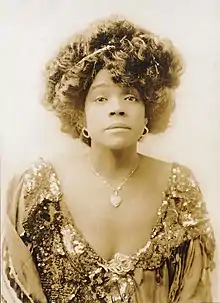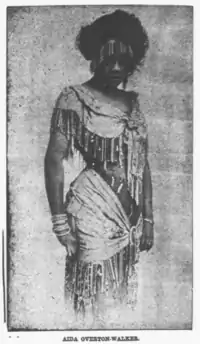Aida Overton Walker
Aida Overton Walker (February 14, 1880 – October 11, 1914), also billed as Ada Overton Walker and as "The Queen of the Cakewalk", was an American vaudeville performer, actress, singer, dancer, choreographer, and wife of vaudevillian George Walker. She appeared with her husband and his performing partner Bert Williams, and in groups such as Black Patti's Troubadours. She was also a solo dancer and choreographer for vaudeville shows such as Bob Cole, Joe Jordan, and J. Rosamond Johnson's The Red Moon (1908) and S. H. Dudley's His Honor the Barber (1911). Aida Overton Walker is also well known for her 1912 performance of the "Salome" dance at Hammerstein's Victoria Theatre. This was Aida's response to the national "Salomania" craze of 1907 that spread through the white vaudeville circuit.[1]
Aida Overton Walker | |
|---|---|
 Walker in 1907 | |
| Born | February 14, 1880 Richmond, Virginia, U.S. |
| Died | October 11, 1914 (aged 34) New York City, New York, U.S. |
| Occupation | Vaudeville |
| Known for | Dancing and choreographing (performing) |
Biography
Aida Overton was born in Richmond, Virginia on February 14, 1880. Her family moved to New York City when she was young. There, she gained an education and considerable musical training.
At 15, she joined John Isham's "Octoroons," a Black touring group. In the following years she became a chorus member in “Black Patti's Troubadours,” where she met her future husband George Walker, a vaudeville comedian. Her early career was defined by her collaborations with him and his partner Bert Williams, who together soon became the major black vaudeville and musical comedy powerhouses of the era. She and George Walker married within a year of meeting.
Overton Walker first gained national attention in 1900, with her performance of "Miss Hannah from Savannah" in the show Sons of Ham. For the next ten years, she was known primarily for her work in musical theater. Her song and dance made her an instant hit with audiences at the time. She, Walker, and Williams worked together on such musicals as In Dahomey (1903), In Abyssinia (1906), and Bandanna Land (1908). In 1904, after two seasons in England touring with In Dahomey, the group returned to New York. She created a version of the Salome dance, a popular dance routine of the time.[2]
Working alongside her husband, Walker's career and performances were praised by critics. Her successes were well known. She was both financially successful and respected by the industry.
In late 1908, Walker's husband fell ill and the partners closed In Dahomey in 1909. She left the stage for a time to care for her husband.
In 1910, Overton Walker joined the Smart Set Company. During this time she also began touring the vaudeville circuit as a solo act. In 1911, she performed in His Honor the Barber with Smart Set Company. Overton Walker performed as a male character in Lovie Dear, as well as in Bandanna Land, in which she took over her husband's role.[3]
Her husband died in 1911. In 1912, Overton Walker went on tour with her show for 16 weeks, then returned to New York, where she performed as Salome at the Paradise Roof Garden on Broadway.[2] Her success at Hamerstein's theatre led to an invitation to return the following year in Bon Bon Buddy, a musical developed from a song which her husband had popularized in Bandanna Land years before. An ode to her late husband, Overton Walker's performance was so successful she was asked to perform two extra weeks.
Walker died suddenly from kidney failure in 1914.[4] She had continued performing until only two months before her death.[3]

In an October 1905 article in The Colored American Magazine, Overton Walker expressed her belief that the performing arts could have an effect on race relations, stating that, "I venture to think and dare to state that our profession does more toward the alleviation of color prejudice than any other profession among colored people."[2][6]
See also
References
- Office of the Dean, "Bad girls of the 20th century: UCI professor's new book highlights four performance icons who embodied and defied stereotypes", review of Jeanne Scheper, Moving Performances: Divas, Iconicity, and Remembering the Modern Stage (Rutgers University Press, 2016), UCI School of Humanities.
- Krasner, David. A Beautiful Pageant: African American Theater Drama and Performance in the Harlem Renaissance 1910–1927. New York: Palgrave Macmillan, 2002, pp. 68–69.
- Thorne, Wells. "The Later Years of Aida Overton Walker; 1911–1914". Black Acts. Archived from the original on June 19, 2017.
- Brian Galindo, "The vaudeville actress who refused to be a stereotype", Buzz Feed
- Taylor, Julius F. "The Broad Ax". Illinois Digital Newspaper Collections. Retrieved June 18, 2015.
- Overton Walker, Aida (October 1905). ""Colored Men and Women on the Stage." The Colored American". HathiTrust. Retrieved March 25, 2019.
Sources
- Brooks, Daphne. "Divas and Diasporic Consciousness" in Bodies in Dissent: Spectacular Performances of Race and Freedom, 1850–1910: 281–342.
- Galindo, Brian. "The Vaudeville Actress Who Refused to Be a Stereotype." Buzzfeed. N.p., September 15, 2013.
- Krasner, David. "Rewriting the Body: Aida Overton Walker and the Social Formation of Cakewalking." Theatre Survey, vol. 37, no. 2 (November 1996): 66–92.
- Kicha. "Aida Overton Walker (1880 – 1914)". N.p., n.d.
- Paula Marie Seniors, "Beyond Lift Every Voice and Sing: The Culture Of Uplift, Identity, and Culture in Black Musical Theater, 2009
External links
| Wikimedia Commons has media related to Aida Overton Walker. |
- Aida Overton Walker Broke Stereotypes: Victorian Era StageAida Overton Walker at Global Performers Database
- "Aida Overton Walker: THE LATER YEARS OF AIDA OVERTON WALKER; 1911–1914", Black Acts, archived March 17, 2015. Accessed December 11, 2017.
- "Joe Jordan, with picture of Aida Overton Walker", Jass.com
- Obituary in The Freeman, October 17, 1914.
- "Aida Overton Walker", Find a Grave database.
- Photograph of Aida Overton Walker as Salome https://digitalcollections.nypl.org/items/8e5e8970-0161-0132-015a-58d385a7bbd0
- Medda Larkin, a character in Newsies, who took in newsboys with nowhere to stay, was based on Aida Overton Walker. https://newsboys-of-1899.tumblr.com/post/171559864966/this-is-aida-overton-walker-she-is-the-real-life
- Aida Overton Walker Broke Stereotypes: Victorian Era Stage https://racingnelliebly.com/strange_times/aida-overton-walker-broke-stereotypes-of-victorian-era-stage/
- How to Cake Walk, by Aida Overton Walker The Tattler, July 1, 1903 (Syncopated Times reprint)